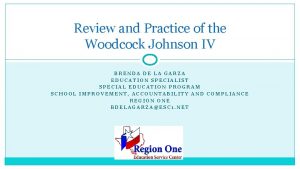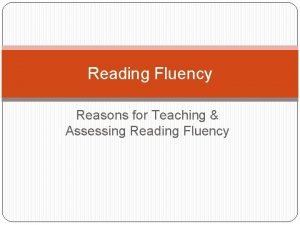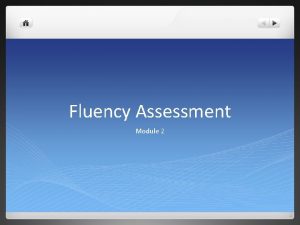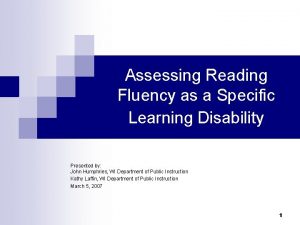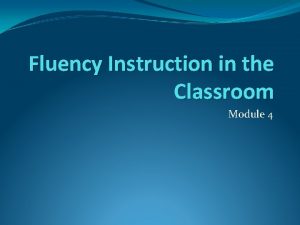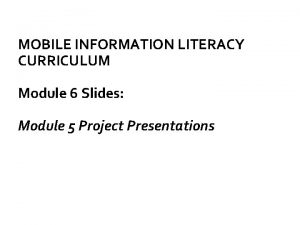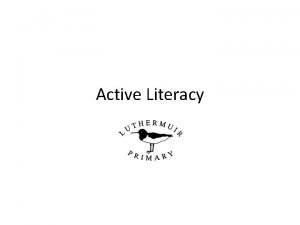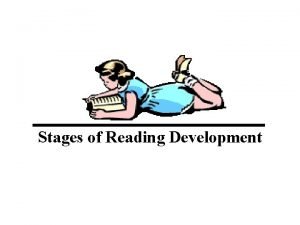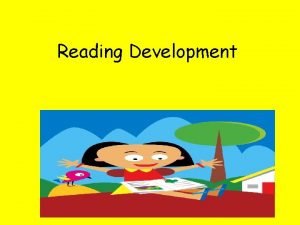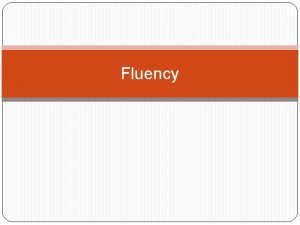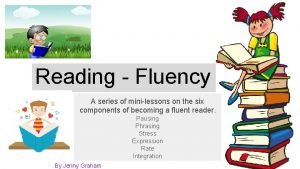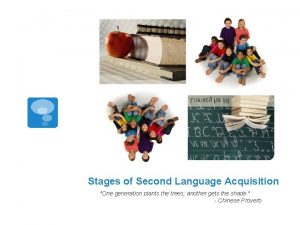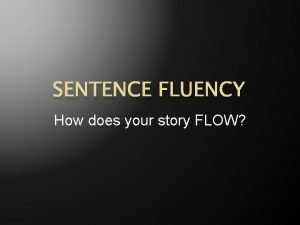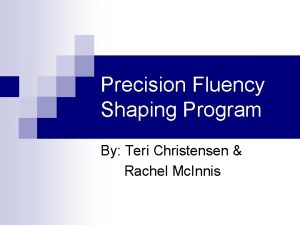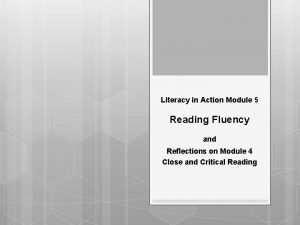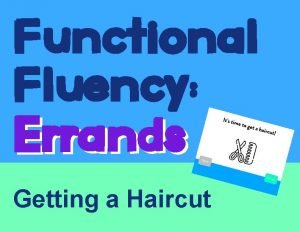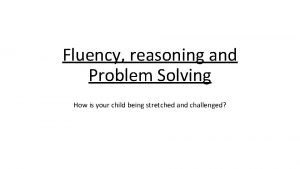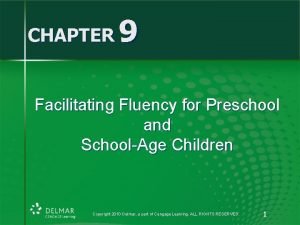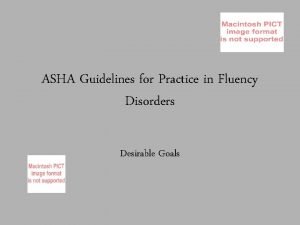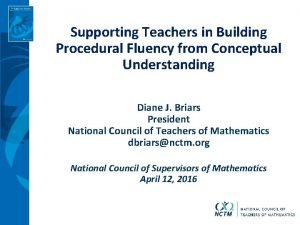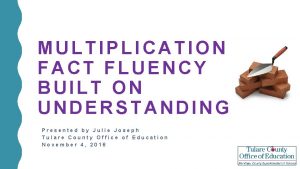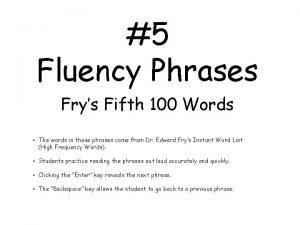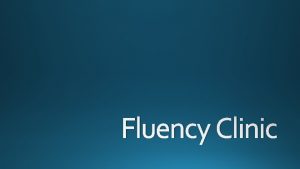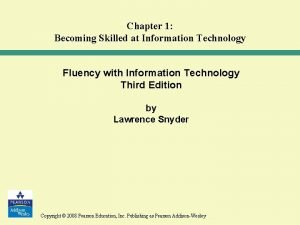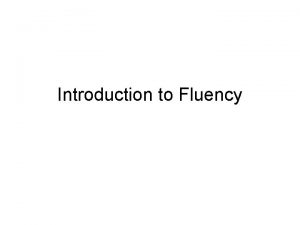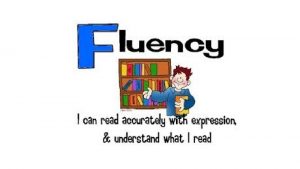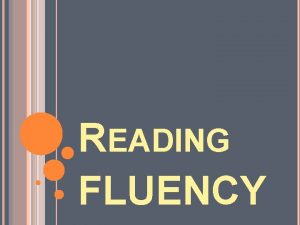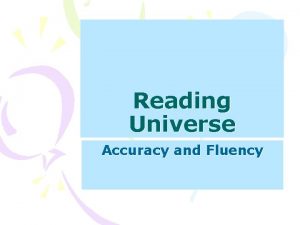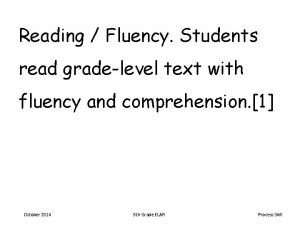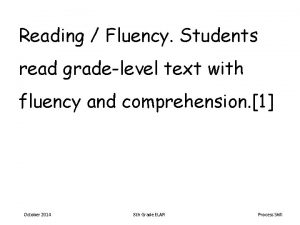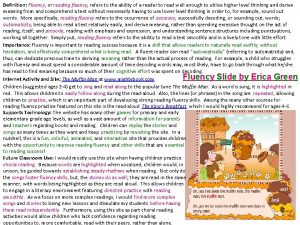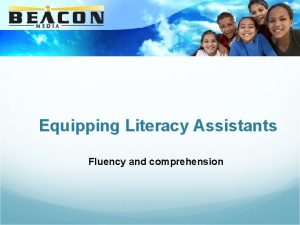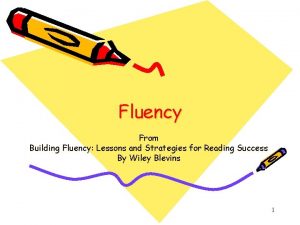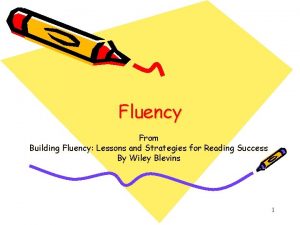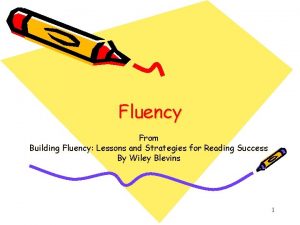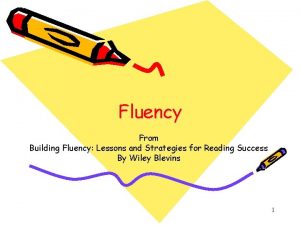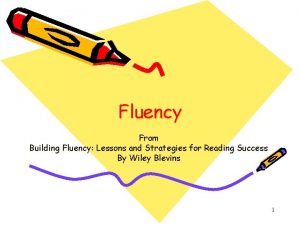Literacy in Action Module 5 Reading Fluency and















































- Slides: 47

Literacy in Action Module 5 Reading Fluency and Reflections on Module 4 Close and Critical Reading

Goals Participants will • Review successes of CCR’s. • Be made aware of the importance of fluency development for adolescents. • Practice fluency assessments. • Learn strategies for developing fluency.

CCR Reflections • Share with your table partners the result of your work with close and critical reading. • What did you notice about the students while employing close and critical reading? üengagement üthinking üsharing • Was one question easier for students than others?

Defining Fluency “Fluency the ability toaread a textaccurately, quickly, and accurately, “Fluency isisthe ability to read text quickly, with proper and is the ability to read a text quickly, accurately, and with proper expression. ” National Reading Panel, National 2000 Reading Panel, 2000 National Reading Panel, 2000 The following updated definition of fluency reflects current research findings. Fluency is the ability to read text accurately and smoothly with proper expression, adjusting the rate for meaning.

Defining Fluency “Fluency combines automaticity, “Fluency is the ability to read aaccuracy, text quickly, accurately, and with properand is the ability to read a text quickly, accurately, and with proper expression. ” oral reading prosody, which, taken together, Panel, 2000 facilitate the reader’s construction. National of Reading meaning. National Reading Panel, 2000 It is demonstrated during oral reading through ease of word recognition, appropriate pacing, phrasing, and intonation. It is a factor in both oral and silent reading that can limit or support comprehension. ” From “Aligning Theory and Assessment of Reading Fluency: Automaticity, Prosody, and Definitions of Fluency” Kuhn, Schwanenflugel, Meisinger, Levy, Rasinski, 2010

Fluency is the Bridge to Comprehension Decoding Words Fluency FLUEN CY Comprehension

Reading Fluency ~ A Bridge Between Decoding and Text Comprehension • Readers must decode and comprehend to gather information from text. • If the speed and accuracy of decoding words are hindered, comprehension is compromised. National Institute for Literacy, What Content Area Teachers Should Know about Literacy, p. 11

Factors Contributing to Fluency Reading Speed (Automaticity) FLUENCY Prosody Accuracy

Silent Reading Rate Directions: Timed Silent Reading Rate • Students or teacher counts and marks a 400 word sample (Anything the students are reading) • Students begin reading when the instructor signals to begin (Students should try to increase their rate BUT NOT read too fast to compromise comprehension) • Teachers display a timer that counts up to 3: 20 minutes • http: //www. online-stopwatch. com/ (Free online stopwatch) • After reaching the 400 th word – record the time displayed on the timer. Write this number down. • Fill in the Progress chart. Plot your reading time on the graph. Be sure to note your words per minute. *** Remember your rates change depending on the text. Dense text demands a slower reading rate. Never let speed interfere with understanding. *** (handout)

Silent Reading Rate Assessment • Read the passage, Science That Saves Lives, for one minute. • Count the number of words you were able to read. • Record the number on the data chart. • Compare your rate to the Silent Reading Rate grade-level Chart.

Silent Reading Rates Grade 1 Grade 2 Grade 3 Grade 4 Grade 5 Grade 6 Grade 7 Grade 8 Grade 9 Grade 12 60 -90 85 -120 115 -140 140 -170 170 -195 195 -220 215 -245 235 -270 250 -300 Harris and Sipay as quoted in Allington

Silent Reading Chart (handout)

Measuring Oral Reading Fluency 1. Ask the student to read aloud a grade level passage that they have never seen or read before for one minute. 2. As the student reads the passage aloud, the teacher/partner notes any errors the student makes. 3. Stop the student after one minute. Count the number of words the student read in the minute and subtract any errors made. For example, if the student read 120 words in a minute and made five errors. The student’s reading rate is 115 words correct per minute.

Oral Reading for Rate and Accuracy Activity • Read the excerpt from Pale Blue Dot by Carl Sagan (for one minute) • Count the number of words, subtract errors • Record the number and compare your numbers to the Oral Reading Rate and Accuracy Chart

ORAL READING RATE -- WCPM

Reading Fluency Chart Date Name of Passage Grade Level 8/3/13 Pale Blue Dot 9 th grade WCPM 130


Fluent readers read text with appropriate • automaticity • rate/speed • accuracy • prosody • proper intonation and expression • variation in rhythmic and tonal aspects of speech (pitch, loudness, speed, rhythm, and pause), which provide the spoken equivalent of written text National Institute for Literacy, What Content Area Teachers Should Know about Literacy, p. 11

Fluency Challenges for Adolescent Readers • lack fluency, read slowly, and often stop to sound out words. • may reread sections of texts to gain comprehension. • may spend so much time and cognitive energy decoding individual words that their focus is drawn away from comprehension.

Factors Influencing Fluency • the level of text difficulty • the degree of familiarity the reader has with the words, content, and genre of the text • the amount of practice with the text • the reader’s metacognitive abilities • the reader’s motivation and engagement

“Is Fluent Expressive Reading Important for HS Readers? ” David Paige, Timothy Rasinski, Theresa Magpuri-Pavell, 2012 • • Dispelling misconceptions about fluency Multidimensional Fluency Scale Prosody and Silent Reading Comprehension scores Choosing materials for prosodic reading Wide and Deep Reading Assisted Reading Take Action “Oral reading prosody is related to silent reading comprehension for secondary students”

Using the Multi-Dimensional Scale Students read orally one of the passages to a reading partner. The partner uses the rubric to score the reader. This will be done twice. • Assign a score (1 to 4 points) on each of 4 dimensions of fluency • Expression and Volume • Phrasing • Smoothness • Pace • A score of ≥ 10 ~ making good progress in fluency • A score of ≤ 8 ~ may need additional instruction in fluency

FLUENCY RUBRIC Score _________ Scores of 10 or more indicate that the student is making good progress in fluency. Scores at or below 8 may indicate that the student may needs additional instruction in fluency. 1 2 3 4 Expression and Volume Reads in a quiet voice as if to get words out. The reading does not sound natural like talking to a friend. Reads in a quiet voice. The reading sounds natural in part of the text, but the reader does not always sound like they are talking to a friend. Reads with volume and expression. However, sometimes the reader slips into expressionless reading and does not sound like they are talking to a friend. Reads with varied volume and expression. The reader sounds like they are talking to a friend with their voice matching the interpretation of the passage. Phrasing Reads word-by-word in a monotone voice. Reads in two or three word phrases, not adhering to punctuation, stress and intonation. Reads with a mixture of run- Reads with good phrasing; ons, mid sentence pauses for adhering to punctuation, stress breath, and some choppiness. and intonation. There is reasonable stress and intonation. Smoothness Frequently hesitates while reading, sounds out words, and repeats words or phrases. The reader makes multiple attempts to read the same passage. Reads with extended pauses or hesitations. The reader has many “rough spots. ” Reads with occasional breaks in rhythm. The reader has difficulty with specific words and/or sentence structures. Reads smoothly with some breaks, but self-corrects with difficult words and/ or sentence structures. Pace Reads slowly and laboriously. Reads moderately slowly. Reads fast and slow throughout reading. Reads at a conversational pace throughout the reading.

Strategies for Oral Reading Repeated/Partner/ Echo Reading Readers’ Theater/ Choral Reading Model and Play with Prosody

Modeling and Repeated Reading Students need to hear explicit models of fluent reading. Kelly Gallagher’s Reading Minute • Collect readings appropriate to your content area • Read orally to students one to five minutes every day • Share an interesting reading selection (poetry, newspaper, magazine, excerpt from current novel) • Model fluent reading • Students listen, then write a one-sentence summary or thesis statement for the “Reading Minute” selection http: //www. stenhouse. com/assets/PDFs/0356 ho. pdf as described in Reading Reasons: Motivational Mini-Lessons for Middle and High School by Kelly Gallagher

Modeling and Repeated Reading Students need to hear explicit models of fluent reading. Adapted Reading Minute Activity • Share oral reading selection (students listen) • Provide copies for students to follow along as you re-read the selection orally to the class • In pairs, students read the selection aloud (paired repeated reading) • Students time paired reading • Note number of words read in one minute • Record WPM on Fluency chart • Each student writes a one-sentence summary

Partner Reading • Students read and reread text with partners. • Assign text on the instructional level of the lower-level reader. • Teach partner reading routine. • Partner 1 reads first paragraph. Partner 2 follows along. • Partner 2 reads the same paragraph. • Students briefly discuss what they just read by retelling what happened or by identifying the main idea of the paragraph. • Repeat steps 1 -3 until passage is complete. Notes from Reading Teachers Sourcebook (Chapter 8 Fluency)

Echo Reading Echo reading will help struggling readers with fluency, reading orally, new vocabulary, and comprehension. All you need is a book on your student's level and a reader for students to echo. It is a simple reading strategy to help your students gain skills. The Process • All readers have a copy of the text. • The teacher or the lead reader reads a line of text. It will depend on the age and ability level of your students when deciding how much to read at one time. • While the leader reads out loud with expression and at a good pace, the rest of the group follows along in the text. • After the reader reads a line or sentence, then the students read it out loud. They try to imitate the way the leader reads the text

Readers’ Theatre • Readers speak clearly, use appropriate volume, read the text accurately and with expression. • Members of the group cooperate; use rehearsal time wisely. Procedure • Select materials to read. • Develop the script. • Assign roles. • Practice, practice • Perform. • Discuss. Readers’ Theater Resources Sample Reader’s Theatre script, Dog’s Breath (handout) Notes from Reading Teachers Sourcebook (Chapter 8 Fluency)

Choral Reading • • • Choose a short text (100 - 150 words) Provide a copy Teacher reads with expression Students join in choral reading Listen for rough spots (Audio record first and last reading) Your turn… Practice a choral reading with the following. “Compassion and the World” (Handout) “Is Fluent Expressive Reading Important for High School Readers? ” David Paige, Timothy Rasinski, Theresa Magpuri-Pavell

“Compassion and the World” (handout) by H. H. , the Fourteenth Dalai Lama Individual happiness can contribute in a profound and effective way to the overall improvement of our entire human community. Because we all share an identical need for love, it is possible to feel that anybody we meet, in whatever circumstances, is a brother or sister. No matter how new the face or how different the dress and behavior, there is no significant division between us and other people. It is foolish to dwell on external differences, because our basic natures are the same. Ultimately, humanity is one and this small planet is our only home. If we are to protect this home of ours, each of us needs to experience a vivid sense of universal altruism. It is only this feeling that can remove the self-centered motives that cause people to deceive and misuse one another. If you have a sincere and open heart, you naturally feel self-worth and confidence, and there is no need to be fearful of others. I believe that at every level of society—familial, tribal, national and international—the key to a happier and more successful world is the growth of compassion. We do not need to become religious, nor do we need to believe in an ideology. All that is necessary is for each of us to develop our good human qualities. I try to treat whoever I meet as an old friend. This gives me a genuine feeling of happiness. It is the time to help create a happier world.

Playing with Prosody Sentence Tunes The changes in meaning are due to what are called supersegmental phonemes (speech sounds or inflection stresses that affect meaning). Directions: Read the sentences below, emphasizing or stressing the bold word to change the meaning of the sentence. I did not say you stole my red hat. Handout The Reading Teacher’s Book of Lists , Fry and Kress (2006), List 125

Features of Fluency – (Play with Prosody) Prosodic Features • Pitch, loudness, speed, pause Paralinguistic Features • Whisper, breathiness, huskies, nasality, over articulation Examples of Prosodic and Paralinguistic Features • Clipped, elongated, louder, softer pause, even pitch, high pitch, low pitch, whisper, nasality, breathiness, lip rounding The Reading Teacher’s Book of Lists, Fry and Kress (2006), List 122

Your turn…(Play with Prosody) In groups of four, take turns reading a sentence or two from one of the paragraphs from Pale Blue Dot. First, read with one of the prosodic features: • Pitch (high or low tone) • Loudness (soft or loud voice) • Speed (fast or slow) • Pause (short or long) Next, read with one of the paralinguistic features: • Whisper, breathiness, huskies, nasality, over articulation


Pacing Dots (handout) Steps: • Get 400 word sample ready. • Determine the rate you are targeting from progress chart and divide the reading into 4 equal time periods to achieve that goal. • Example: Desired rate 200 words per minute - The 400 word sample must be read in 2 minutes. Therefore, each dot would represent 30 seconds. • Students begin reading when the instructor signals to begin. (Students should try to increase their rate BUT NOT read too fast to compromise comprehension. ) • Teacher makes a sound at the targeted times to achieve the desired rate. In example above, teacher would say “dot” at the 30 second, one minute, 90 second, and 2 minute marks. • Students should be reading the line beside the dot when you give the signal. If they are not at the dot, move to the dot and continue reading. Adjust your pace to attempt to read at this rate. This may be distracting at first but will get easier over time.

Why do pacing dots? • Students experience how it “feels” to read at the target rate • Students begin to break a pattern of reading everything at one rate • Helps increase speed necessary for timed readings (ACT) Your turn… Try this activity with the passage, The Social Function of Science. (handout)

Cloze procedure for increasing silent reading rate • Select a text of approximately 400 words. Teacher reads the text, students follow the text silently reading along. • The teacher pauses between 5 to 7 words and the students orally read the word. • The teacher controls the rate.


Resources Florida Oral Reading Fluency and MAZE Assessments (Grade-Level Resources) http: //www. fcrr. org/forf_mazes/forf 10 -11. shtml MAZE Risk Levels http: //www. fcrr. org/assessment/pdf/forf-maze/Risk_Levels_Maze_6 -8_1011. pdf http: //www. fcrr. org/assessment/pdf/forf-maze/Risk_Levels_Maze_9 -12_1011. pdf ORF Risk Levels http: //www. fcrr. org/assessment/pdf/forf-maze/Risk_Levels_FORF_6 -8_1011. pdf http: //www. fcrr. org/assessment/pdf/forf-maze/Risk_Levels_FORF_9 -12_1011. pdf

Resources MI Comprehensive Literacy Profile/Plan http: //comprehensiveliteracy. weebly. com/reading-fluency. html Assessments - NAEP Oral Reading Fluency Scale - Multi-Dimensional Fluency Rubric - Oral/Silent Reading Fluency CBM Strategies - Guided Highlighted Reading Choral Reading Readers’ Theatre (Theater) Repeated Readings “Is Fluent, Expressive Reading Important for High School Readers? ” Paige, Rasinski, Magpuri-Lavell Interventions – role of automaticity of basic component skills, and how students can instinctively associate what words look like with what they mean - Repeated Readings for Juncture and Phrasing

Assignment: • Provide reading fluency development with one of your classes. • This will consist of reading fluency progress monitoring, instructional activities, and data collection on individual students’ fluency development. • During the next month, you will adjust the selected passages to challenge your students’ fluency development. • Bring your student data and a list of the activities you used to the last module presentation.

Selection of the Passage • You have been provided with grade-level passages from grade 6 to HS levels. • If you need lower level passages, go to the North Carolina passages on www. missionliteracy. com • Begin with a passage you think all students will be able to read fluently. • Have students read silently for one minute. (You time. ) • Students mark where they finish. They record the name of the passage and grade and how many words they read. • Students go back and highlight the words they didn’t know. • Teacher explains the words missed most frequently. • If students read the entire passage fluently, provide the students with next level passage for the next read.

Record Sheet Name_____________ Passage Title Grade WPM Date Grade_______ # of Words Dimensions Not Known of Fluency: Expression/volume___ Phrasing___ Smoothness___ Pace___ Expression/volume___ Phrasing___ Smoothness___ Pace___

Using the Multi-Dimensional Scale students read orally one of the passages to a reading partner. The partner uses the rubric to score the reader. This will be done twice. • Assign a score (1 to 4 points) on each of 4 dimensions of fluency • Expression and Volume • Phrasing • Smoothness • Pace • A score of ≥ 10 ~ making good progress in fluency • A score of ≤ 8 ~ may need additional instruction in fluency

FLUENCY RUBRIC Scores of 10 or more indicate that the student is making good progress in fluency. Score _________ Scores at or below 8 may indicate that the student may need additional instruction in fluency. 1 2 3 4 Expression and Volume Reads in a quiet voice as if to get words out. The reading does not sound natural like talking to a friend. Reads in a quiet voice. The reading sounds natural in part of the text, but the reader does not always sound like they are talking to a friend. Reads with volume and expression. However, sometimes the reader slips into expressionless reading and does not sound like they are talking to a friend. Phrasing Reads word-by-word in a monotone voice. Reads in two or three word phrases, not adhering to punctuation, stress and intonation. Reads with a mixture of run- Reads with good phrasing; ons, mid sentence pauses for adhering to punctuation, stress breath, and some choppiness. and intonation. There is reasonable stress and intonation. Smoothness Frequently hesitates while reading, sounds out words, and repeats words or phrases. The reader makes multiple attempts to read the same passage. Reads with extended pauses or hesitations. The reader has many “rough spots. ” Reads with occasional breaks in rhythm. The reader has difficulty with specific words and/or sentence structures. Reads smoothly with some breaks, but self-corrects with difficult words and/ or sentence structures. Pace Reads slowly and laboriously. Reads moderately slowly. Reads fast and slow throughout reading. Reads at a conversational pace throughout the reading. Reads with varied volume and expression. The reader sounds like they are talking to a friend with their voice matching the interpretation of the passage.

Thank you for your participation. May all your students be fluent readers!
 While reading activities
While reading activities Woodcock johnson test of cognitive abilities
Woodcock johnson test of cognitive abilities Word reading accuracy
Word reading accuracy Reading fluency checklist
Reading fluency checklist Cbm reading fluency passages
Cbm reading fluency passages Definition of reading fluency
Definition of reading fluency Fluency oriented reading instruction
Fluency oriented reading instruction Intervention central reading fluency
Intervention central reading fluency Information and media literacy similarities
Information and media literacy similarities Media and information literacy ppt
Media and information literacy ppt Differentiate people as media and people in media
Differentiate people as media and people in media Cyber literacy and digital literacy
Cyber literacy and digital literacy Media and information literacy module 6
Media and information literacy module 6 C device module module 1
C device module module 1 Reading and writing module 6
Reading and writing module 6 Reading pyramid
Reading pyramid Literacy stages of reading development
Literacy stages of reading development Confirmation and fluency stage
Confirmation and fluency stage Accuracy and fluency
Accuracy and fluency Fountas and pinnell fluency rubric
Fountas and pinnell fluency rubric What are the aims of teaching reading
What are the aims of teaching reading While reading stage
While reading stage What is extensive reading
What is extensive reading Intensive and extensive reading
Intensive and extensive reading How to develop reading skills in students
How to develop reading skills in students Acquisition, fluency maintenance generalization examples
Acquisition, fluency maintenance generalization examples Speech emergence stage activities
Speech emergence stage activities What is sentence fluency
What is sentence fluency Precision fluency shaping program
Precision fluency shaping program Lli grade level chart
Lli grade level chart Van riper tekniği pdf
Van riper tekniği pdf Intercultural fluency
Intercultural fluency Functional fluency
Functional fluency Fluency with information technology
Fluency with information technology Fluency reasoning problem solving
Fluency reasoning problem solving Fluency friday
Fluency friday Preschool fluency activities
Preschool fluency activities Orthodox lift in care
Orthodox lift in care Fluency shaping goals
Fluency shaping goals Procedural fluency examples
Procedural fluency examples Building fact fluency graham fletcher
Building fact fluency graham fletcher Fry's fluency phrases
Fry's fluency phrases Fluency rules program
Fluency rules program Solution fluency
Solution fluency Computational fluency
Computational fluency Information technology fluency
Information technology fluency Dibels first sound fluency
Dibels first sound fluency Fun with fluency
Fun with fluency

